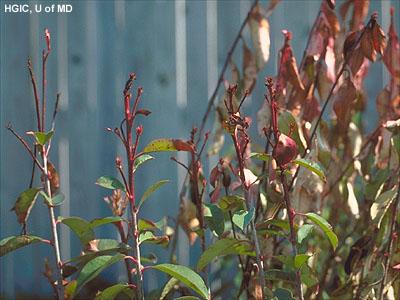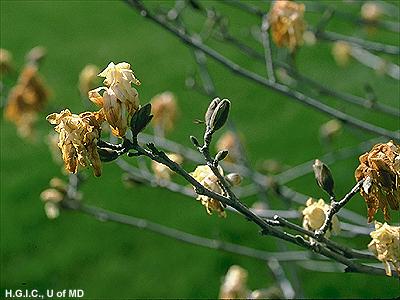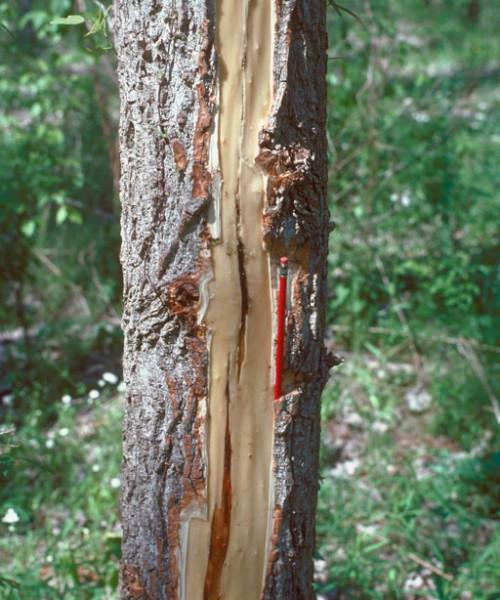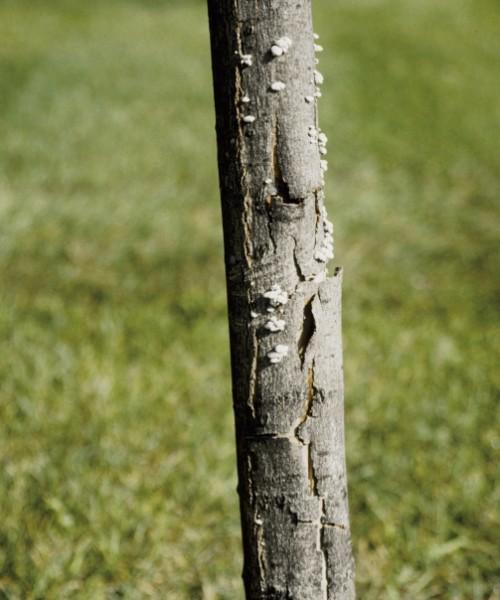Winter damage can occur on many plants. A rapid temperature drop following a mid-winter thaw can cause bark splitting. Dead twigs and branches in the spring may be the result of ice and snow damage from the winter.
Ice and snow damage
- Symptoms include bent or broken branches from the heavyweight of the ice or snow.
- Heavy snow can be gently knocked from branches, but branches that are iced over may actually be more brittle and suffer further damage if removal is attempted.
- Wind during ice storms will cause the most damage.
- White pines in our area are especially prone to winter ice and wind damage.
Winter color of evergreens

Winter damage symptoms on boxwood
- Symptoms of winter damage can include a change from the normal green color to gray, yellow, blue, purple, bluish-green, brown, and bronze leaves or needles.
- Examples of plants that are often damaged by extreme winter weather include
1) Japanese cedar (Cryptomeria) turn bronze
2) Yew (Taxus buccata) turn brown
3) Eastern red cedar (Juniperus virginiana) turn brown
4) Arborvitae (Thuja spp.) turn brown
5) Creeping juniper (Juniperus horizontalis) turn purple
6) White pines (Pinus strobus) turn yellow
7) Boxwood (Buxus spp.) turn yellow-orange
- Examples of plants that are often damaged by extreme winter weather include
- Some evergreens such as Leyland cypress and spruce usually don’t change color. Dieback in Leyland cypress can occur under extreme winter temperature fluctuations. (Read on our blog: Why Is Leyland Cypress Turning Brown?)

Severe winter damage on Leyland cypress. Photo: David L. Clement
- Causes of ‘winter color’ can include low temperatures and drought stress. Often, the foliage colors will revert back to normal when springtime temperatures return to normal.
 English
English العربية
العربية Български
Български 简体中文
简体中文 繁體中文
繁體中文 Hrvatski
Hrvatski Čeština
Čeština Dansk
Dansk Nederlands
Nederlands Suomi
Suomi Français
Français Deutsch
Deutsch Ελληνικά
Ελληνικά हिन्दी
हिन्दी Italiano
Italiano 日本語
日本語 한국어
한국어 Norsk bokmål
Norsk bokmål Polski
Polski Português
Português Română
Română Русский
Русский Español
Español Svenska
Svenska Català
Català Filipino
Filipino עִבְרִית
עִבְרִית Bahasa Indonesia
Bahasa Indonesia Latviešu valoda
Latviešu valoda Lietuvių kalba
Lietuvių kalba Српски језик
Српски језик Slovenčina
Slovenčina Slovenščina
Slovenščina Українська
Українська Tiếng Việt
Tiếng Việt Shqip
Shqip Eesti
Eesti Galego
Galego Magyar
Magyar Maltese
Maltese ไทย
ไทย Türkçe
Türkçe فارسی
فارسی Afrikaans
Afrikaans Bahasa Melayu
Bahasa Melayu Kiswahili
Kiswahili Gaeilge
Gaeilge Cymraeg
Cymraeg Беларуская мова
Беларуская мова Íslenska
Íslenska Македонски јазик
Македонски јазик יידיש
יידיש Հայերեն
Հայերեն Azərbaycan dili
Azərbaycan dili Euskara
Euskara ქართული
ქართული Kreyol ayisyen
Kreyol ayisyen اردو
اردو বাংলা
বাংলা Bosanski
Bosanski Cebuano
Cebuano Esperanto
Esperanto ગુજરાતી
ગુજરાતી Harshen Hausa
Harshen Hausa Hmong
Hmong Igbo
Igbo Basa Jawa
Basa Jawa ಕನ್ನಡ
ಕನ್ನಡ ភាសាខ្មែរ
ភាសាខ្មែរ ພາສາລາວ
ພາສາລາວ Latin
Latin Te Reo Māori
Te Reo Māori मराठी
मराठी Монгол
Монгол नेपाली
नेपाली ਪੰਜਾਬੀ
ਪੰਜਾਬੀ Afsoomaali
Afsoomaali தமிழ்
தமிழ் తెలుగు
తెలుగు Yorùbá
Yorùbá Zulu
Zulu ဗမာစာ
ဗမာစာ Chichewa
Chichewa Қазақ тілі
Қазақ тілі Malagasy
Malagasy മലയാളം
മലയാളം සිංහල
සිංහල Sesotho
Sesotho Basa Sunda
Basa Sunda Тоҷикӣ
Тоҷикӣ O‘zbekcha
O‘zbekcha አማርኛ
አማርኛ Corsu
Corsu Ōlelo Hawaiʻi
Ōlelo Hawaiʻi كوردی
كوردی Кыргызча
Кыргызча Lëtzebuergesch
Lëtzebuergesch پښتو
پښتو Samoan
Samoan Gàidhlig
Gàidhlig Shona
Shona سنڌي
سنڌي Frysk
Frysk isiXhosa
isiXhosa







